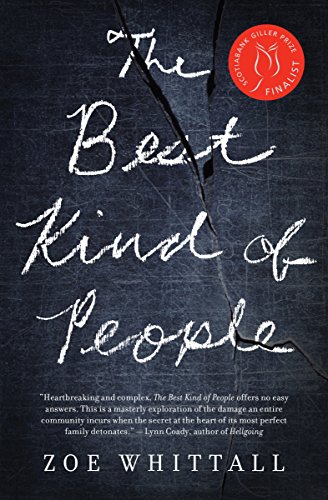3.5 Stars
I decided
to read this novel because of its appearance on the shortlist for the Giller
Prize. Unfortunately, I was not as
enthralled with it as others have been.
At the
beginning of the novel, a pillar of the community and highly respected prep-school
teacher, George Woodbury, is arrested and charged with four counts of sexual
misconduct with minors and attempted rape of a minor. The rest of the novel focuses on the impact of
those charges on his family: his wife
Joan, a trauma nurse; 17-year-old Sadie, George’s popular, high-achieving
daughter; and Andrew, the gay son, a lawyer who lives with his partner in New
York.
The reader
is taken into the minds of these three family members. George, however, remains a secondary
character. Obviously, his thoughts are
kept hidden in order to create suspense:
is he guilty or innocent? A year
in the lives of these three is detailed, ending with the trial (though there is
an epilogue as well).
The family’s
conflict is clearly stated by Joan: “’You
don’t stop loving someone in an instant because somebody accuses them of
something despicable’” (87). As
expected, they vacillate between believing George to be innocent and thinking
he might be guilty. People in their
affluent community quickly choose sides.
Many view the Woodbury family, especially Joan, as complicit enablers so
they quickly become social pariahs: “Joan
was no longer a mother and a nurse and a person with her own history. She symbolized evil, and for that, people
were not kind” (95). Joan is totally
shocked by the charges and realizes that, if George is guilty, then she has
been a blind fool. What the reader comes
to realize is that they are all collateral damage, either victims of George’s
behaviour or victims of lying girls.
What is
emphasized throughout is that the Woodbury family is powerless. Joan summarizes their predicament to her
sister Clara: “’It’s not as though I
have control over the story that gets played out in the media either. . . . I
have to just give up and let the sharks eat me – the cops, the lawyers, the
media, the opportunistic, exploitative writers . . . I have no control, Clara. And that is the entirety of the life lesson I
have learned from this experience. No
one has control. At all’” (345).
It is obvious
that the author has studied rape culture and real examples of sexual assault
cases. Jian Ghomeshi and Bill Cosby came to
mind. Whittall also refers to a case
which reminded me of the Russell Williams case:
“the high commander in the US Army had been tried and convicted for two
murders and dozens more sexual assaults, as well as a string of break-ins and
robberies of women’s undergarments” (286).
One of the victims sued Williams’ wife, arguing that she could not have
been oblivious to his predatory behaviour but did not report that conduct to
the police. Joan Woodbury could be Mary Harriman.
One thing
that bothered me is how little Joan knows about the case. Other than questioning her husband, she does
little to get to the truth. She doesn’t
seem to speak to George’s lawyer on a regular basis to stay informed about the
progress of the defense’s case. George
is charged and then nothing is done for eight months?
The book is
not an easy read. The onslaught of
taunts, and vicious hate mail/voice messages endured by the family had me
feeling bombarded. Watching their lives
and relationships fray is emotionally exhausting, so the author succeeds in
making the reader feel to some extent what Joan, Sadie and Andrew feel. Though the characters had my sympathy, I didn’t
feel connected to them somehow. Would
first-person narration have helped so there wouldn’t be a distancing between
the characters and the reader?

No comments:
Post a Comment